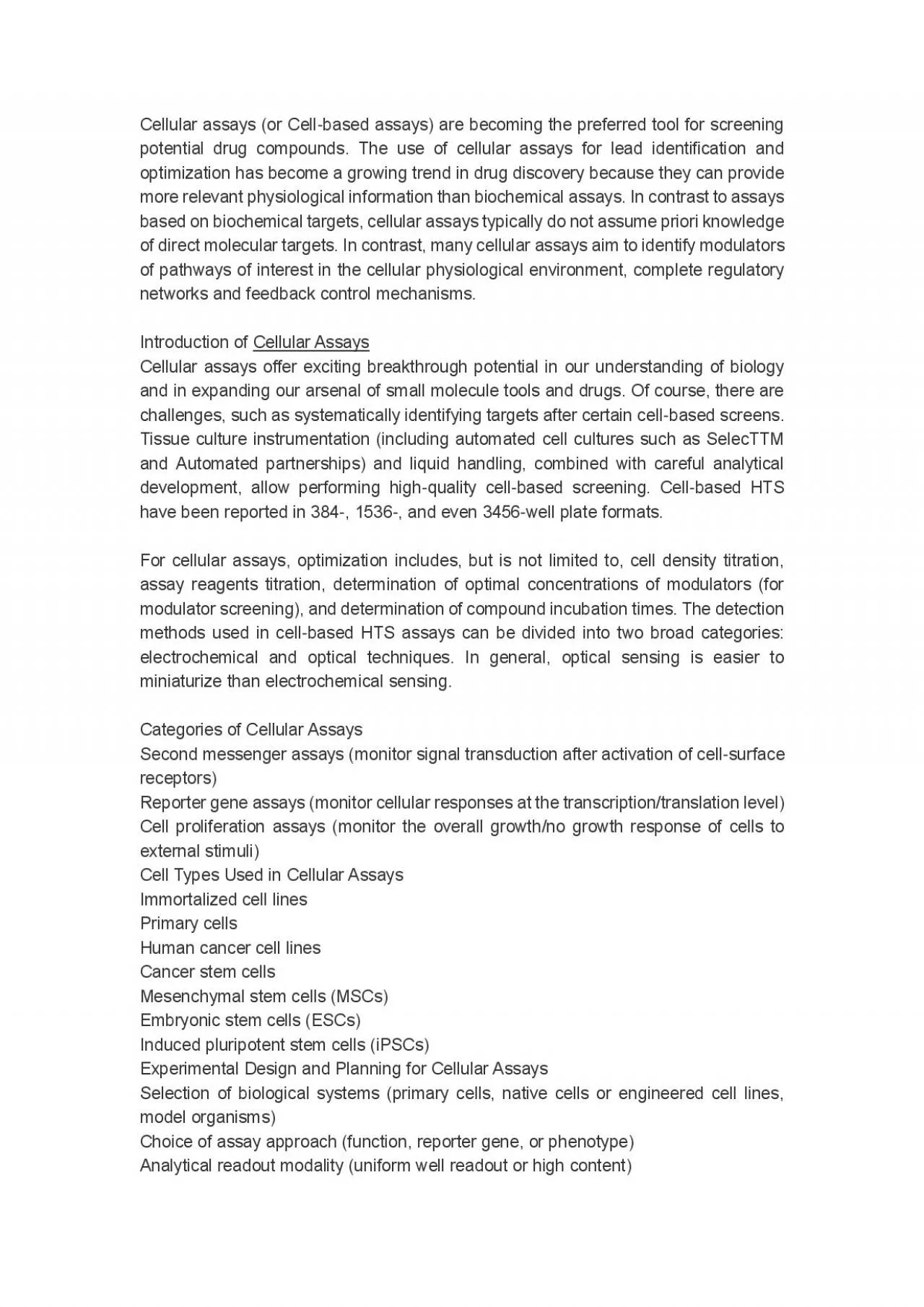/


Cellular assays or Cellbased assays are becoming the preferred tool for screening potential drug compounds The use of cellular assays for lead identification and optimization has become a growing trend in drug discovery ID: 1004215
Download Pdf The PPT/PDF document "High-Throughput Biology by BOC" is the property of its rightful owner. Permission is granted to download and print the materials on this web site for personal, non-commercial use only, and to display it on your personal computer provided you do not modify the materials and that you retain all copyright notices contained in the materials. By downloading content from our website, you accept the terms of this agreement.
Cellular assays (or Cell - based assays) are becoming the preferred tool for screening potential drug compounds. The use of cellular assays for lead identification and optimization has become a growing trend in drug discovery because they can provide more relevant physiological information than biochemical assays. In contrast to assays based on biochemical targets, cellular assays typically do not assume priori knowledge of direct molecular targets. In contrast, many cellular assays aim to identify modulato rs of pathways of interest in the cellular physiological environment, complete regulatory networks and feedback control mechanisms. Introduction of Cellular Assays Cell ular assays offer exciting breakthrough potential in our understanding of biology and in expanding our arsenal of small molecule tools and drugs. Of course, there are challenges, such as systematically identifying targets after certain cell - based screens. Tissue culture instrumentation (including automated cell cultures such as SelecTTM and Automated partnerships) and liquid handling, combined with careful analytical development, allow performing high - quality cell - based screening. Cell - based HTS have been r eported in 384 - , 1536 - , and even 3456 - well plate formats. For cellular assays, optimization includes, but is not limited to, cell density titration, assay reagents titration, determination of optimal concentrations of modulators (for modulator screening), and determination of compound incubation times. The detection methods used in cell - based HTS assays can be divided into two broad categories: electrochemical and optical techniques. In general, optical sensing is easier to miniaturize than electrochemical sensing. Categories of Cellular Assays Second messenger assays (monitor signal transduction after activation of cell - surface receptors) Reporter gene assays (monitor cellular responses at the transcription/translation level) Cell proliferation assays (mo nitor the overall growth/no growth response of cells to external stimuli) Cell Types Used in Cellular Assays Immortalized cell lines Primary cells Human cancer cell lines Cancer stem cells Mesenchymal stem cells (MSCs) Embryonic stem cells (ESCs) Induced p luripotent stem cells (iPSCs) Experimental Design and Planning for Cellular Assays Selection of biological systems (primary cells, native cells or engineered cell lines, model organisms) Choice of assay approach (function, reporter gene, or phenotype) Anal ytical readout modality (uniform well readout or high content) Consider subsequent biological experiments (counter screens, secondary assays, target identification, in vivo validation) Determine data analysis strategies (for the interpretation of data gene rated during assay development, HTS, and subsequent assay) Advantages of Cellular Assays In contrast to a single predefined step under the biochemical approach, the entire pathway of interest in cellular assays can be interrogated, providing opportunities for multiple potential intervention points. Not only expands the variety of targets, but plausibly also provides additional chemical structures as a starting point for lead identification. Allowing the selection of compounds that can cross the cellular membranes and can also provide indications of acute cytotoxicity as an early alert for later - stage lead/probe discovery efforts. Evaluating the effectiveness of compo unds in a cellular environment, which is essential to understand the behavior of compounds in biological systems and aligning readouts with translatable biomarkers. Applications Cellular assays can distinguish between agonists and antagonists, identify al losteric modulators, and provide direct information on compounds related to cell permeability and intracellular stability, as well as acute cytotoxicity. Cellular assays have been widely used to analyze the effects of compounds on cell activity, including nuclear size, mitochondrial membrane potential, intracellular calcium level, membrane permeability, and cell number. Cellular assays can be carried out in more biologically relevant microenvironments, thus representing a good compromise between whole org anisms and in vitro biochemical systems. Cellular assays can provide typical tissue - specific responses and it has been used for early drug discovery, from target identification and validation to primary screening, lead identification and optimization, and safety and toxicology screening.